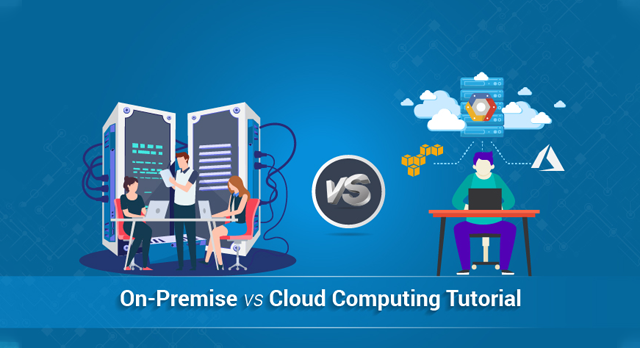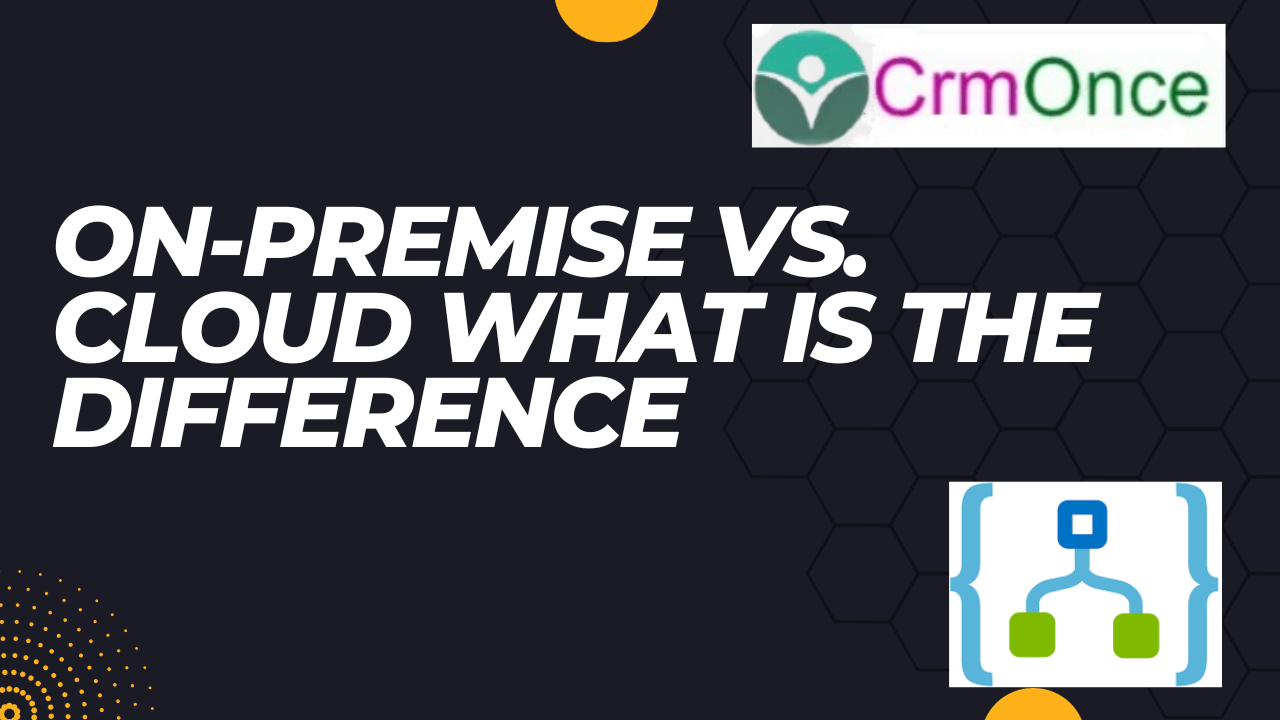On-Premise vs Cloud in azure
In the world of technology, the deployment of IT infrastructure and applications has undergone a significant transformation over the years.
With the arrival of cloud computing, organizations have the option to move their IT infrastructure and applications from On-Premise to the Cloud.
However, with this change, the question of whether to go for on-premise or cloud deployment arises.
On-Premise and Cloud are two concepts that are sometimes used interchangeably. People need help to identify the crucial distinction that sets these technologies apart.

What is On-Premise?
Software that is installed and utilized on the customer’s own hardware in their own data center is called On-Premise
Traditionally, On-Premise software is licensed, which means the client must pay a one-time fee in order to own it and install it on their own servers. All software upkeep, security, and upgrades are the customer’s responsibility.
Nowadays, most On-Premise computer assets are entirely owned by the business and need a sizable capital commitment to buy, install, and deploy.
In order to maintain their computing systems operating smoothly, many businesses hire a dedicated IT staff or specialist. Ongoing costs and maintenance are also entirely undertaken by the business.
Almost every business has On-Premise systems that were gradually put in place as computer power and business requirements increased.
Businesses with a sizable IT workforce and the means to operate their own software may find On-Premise software to be cost-effective.
Cloud-based solutions may be more affordable and simpler to manage for smaller companies.
What is Cloud?
A network of distant computers housed on the Internet is used in Cloud Computing to store, manage, and process data.
It is a method of providing computer services, including storage, database, networking, software, analytics, and more, through the Internet.
Businesses may get these services on demand and only pay for what they really use, thanks to Cloud Computing.
A growing sector of the economy, cloud computing uses virtualization and convergence to accommodate different systems running concurrently on server platforms.
The three basic classifications of these services are “software as a service(SaaS),” “platform as a service(PaaS),” and “infrastructure as a service(IaaS)”.
These areas provide a holistic perspective of Cloud Computing and are related to one another. The model presents the wide range of cloud computing services in a tiered manner, working its way up from the lowest level of the computing stack.
Governments, businesses, public and private institutions, and research groups that create more efficient and demand-driven computer service systems can benefit from Cloud Computing.
Difference Between On-Premise vs Cloud
In the above sections, we have seen what actually On-Premise and Cloud mean. Now, we will examine the key distinctions between On-Premise and Cloud Computing based on various considerations.
CONSIDERATION
- IT Resources
- Software Investment
- Mobile Access
- Customization/Integration
- Control Over Corporate Data
CLOUD
- Must trust third parties with data.Upgrades are handled by the vendor, which eliminates the requirement for internal resources.
- A license fee plus a monthly recurring payment.
- Mobile access is available for Cloud.
- Cloud is usually easy to configure instead of being highly customized.
ON-PREMISES
- Internal system administrator and IT support are required for upgrades.
- Extra 20–25% a month for maintenance and support on top of the license charge.
- Mobile access for On-Premise is not always possible.
- In-depth customization and integration are possible in On-Premise.
- Local control of corporate data in On-Premise.
On-Premise Advantages and Disadvantages
On-Premise uses the infrastructure at your business’ physical location to manage your data. The lifecycle management will be your responsibility, and you will own all of the equipment.
On-Premise solutions for data storage have both advantages and disadvantages, as you might expect. Let’s see each of them separately.
Advantages
Despite the recent popularity of cloud storage, some businesses continue to favor On-Premise solutions for their operational requirements.
For instance, many people value the increased data protection that On-Premise solutions and storage providers. For your company, on-site storage can be a fantastic solution because it can:
One of the main benefits of On-Premise storage is that users can access data without an Internet connection.
Despite the fact that the majority of organizations rely on the Internet to do business, there is always the worry that the loss of a connection might lower productivity and make it challenging to obtain crucial data.
Your internal network will be accessible at any time, regardless of your Internet connection, thanks to On-Premise servers.
You might be able to avoid paying for a fast connection if your organization doesn’t depend on the Internet or cloud-based services.
The demand for a reliable connection with rapid download speeds is further decreased for those who have On-Premise storage.
You may not be required to pay for a more premium internet plan when you don’t need to access the Cloud to see files, depending on your demands.
Unlike cloud storage, which is more accessible to outsiders and prying eyes, on-premises storage is completely hidden from everyone but only authorized employees may use it.
On-premises servers are unavailable from the outside of the network since they are not maintaining the data online.
On-Premise storage might be the best choice for businesses that deal with sensitive data, such as those in the financial sector
Disadvantages
On-site storage has many benefits, but there are also some disadvantages of which businesses need to be aware. For your company, off-site storage might not be the ideal option for the following reasons:
If you want to use On-Premise storage, you’ll additionally require IT personnel to administer and maintain your servers.
This could require you to hire additional workers or for your current staff to spend more time maintaining the servers.
As a result of the increased workload placed on your IT department, this additional support could raise your costs and decrease the productivity of your team.
In addition to the initial infrastructure expenditure needed to buy servers and other infrastructural facilities, you’ll need to maintain spending on hardware, software, and license in order to update or repair the system.
It is common for hardware to malfunction and require replacement. You’ll also need to upgrade your equipment, which will undoubtedly be required at least once a year and cost extra money, in order to get the most out of your server investment.
The foundation of your company is data. Both your performance and your reputation may take a hit if you lose it.
With On-Premise storage, you run the risk of actually losing your data if the system fails or if a compromised system is held hostage.
Cloud Advantages and Disadvantages
Cloud Computing is a popular technology, as we are all aware. Nearly every business moved its services to the cloud to boost business growth.
Let’s go through some significant benefits and drawbacks of Cloud Computing.
Advantages
Cloud Computing offers various advantages that can boost business growth.
One of the financial benefits of Cloud Computing is that all processing takes place on the cloud and not on your local computer. You don’t have to buy powerful or expensive equipment in order to use cloud computing.
Users will not have any delays while turning on/off their computers as no programs or files are loaded on the local PC.
Additionally, the internal network will operate much more quickly as there won’t be any internal traffic.
Less IT infrastructure costs
With the use of Cloud Computing technology, the IT departments of large companies may see a reduction in infrastructure-related costs.
IT staff can employ Cloud Computing to supplement or replace internal computing resources rather than spend more money on more powerful servers.
Disadvantages
We have seen the various benefits of Cloud Computing; now it is our responsibility to see some of the disadvantages of this technology.
If your Internet connection is down, you cannot work. Since you must have the Internet to connect to your “cloud PC,” you will be unable to do so if there is none.
It is crucial to note that Cloud Computing cannot function with sluggish Internet connections because huge documents and web-based programs sometimes demand a lot of download capacity.
Information is kept “in the cloud.” However, the cloud’s location and security level remain unknown. Users who have confidential data may have these queries which is a big drawback of cloud technology.
For any help or queries contact us on info@crmonce.com or +91 9014146800

